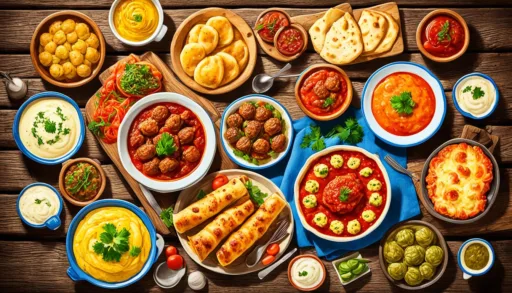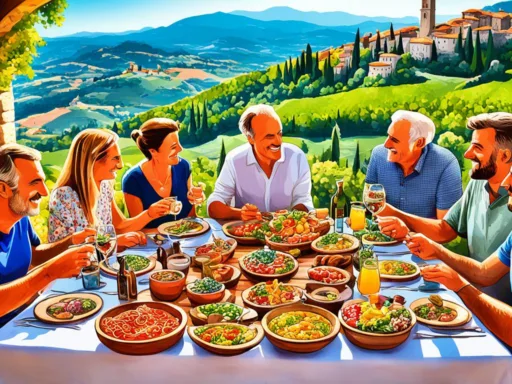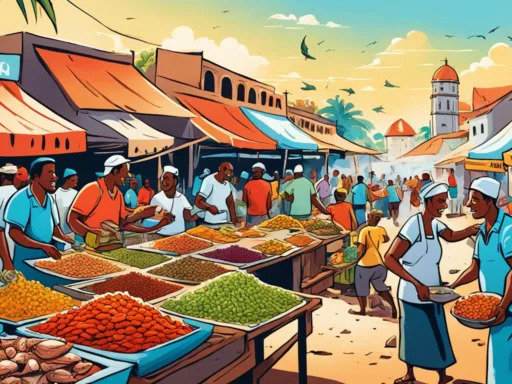Eastern Europe harbors a treasure trove of gastronomic delights, but how many culinary aficionados have ventured into the heart of Moldova’s rich agricultural legacy to discover its food? Nestled snugly between Romania and Ukraine, Moldova offers a spectacular opportunity for travelers to dive into a world of culinary surprises. Moldovan Food Discoveries take you on a flavorful journey through Moldovan cuisine, with dishes weaving together Turkish, Russian, and Ukrainian influences into a fusion that will delight your taste buds. The essence of traditional Moldovan dishes lies in the celebration of seasonal produce and a return to the roots of simple yet hearty cooking, using ingredients harvested from Mother Nature’s bosom, to present a taste of Moldova’s cultural and culinary heritage.
Key Takeaways
- Discover the cultural fusion that influences traditional Moldovan meals and recipes.
- Learn why Moldova’s use of fresh, locally grown ingredients is crucial to its gastronomy.
- Explore the unique tastes brought about by Moldova’s mix of Eastern and Western culinary traditions.
- Understand the significance of agriculture in shaping Moldovan culinary heritage.
- Reveal the diversity encapsulated in authentic Moldovan dishes that tell a story of the land and its people.
Exploring the Hidden Gem of Eastern Europe: Moldova
As Europe’s lesser-sung enclaves call out to the hearts of explorers, Moldova emerges—a nation where cultural layers weave through the fabric of its society. Through a lens finely balanced between past and present, this diminutive yet resplendent country reveals its story—one etched in the earth of its sprawling vineyards and echoed in the bustling streets of its cities. From the tranquil allure of its rolling hills to the vibrant pulse of urban life, Moldova presents an eclectic tapestry of experiences, beckoning travelers in search of genuine encounters and Moldovan Food Discoveries.
The Contrast of Modern and Traditional in Moldovan Cities
In Moldova, the past is not overshadowed but embraced alongside the strides of modernity. One can stroll through Chisinau, the capital city, and observe how revolutionary buildings stand tall, keeping watch over ancient churches. The scents of authentic Moldovan meals drift from open windows, marrying the aromas of freshly baked bread with the zest of contemporary spaces. It is a place where the heartbeat of Moldovan food culture thrums in markets brimming with popular Moldovan foods and whispers in the quietude of historical quarters.
Wizz Air: Your Gateway to Moldovan Adventures
For those yearning to unearth the treasures of Moldova, Wizz Air lays out an inviting red carpet. As a bridge between nations, this airline simplifies the journey to Moldovan soil, making the bounties of this country accessible. Whether it’s to bask in the serene twilight of a Moldovan vineyard or to indulge in the labyrinth of tastes served upon a local diner’s plate, Wizz Air is the trusted companion for adventurers seeking to savor a corner of the world unspoiled by the hands of time.
Moldovan Food Discoveries: A Blend of Cultures at the Dinner Table
The essence of Moldovan gastronomy is its incredible diversity, reflecting a rich Moldovan food culture that is both traditional and dynamic. The dinner table in Moldova is where the crossroads of Europe and Asia deliciously converge, resulting in traditional Moldovan dishes that are vibrant in both flavor and history. This is where the stories of the past and the ingenuity of the present are savored in every bite of Moldovan cuisine.

Creamy polenta, savory stews, and hearty soups are not just staples but symbols of the nation’s welcoming spirit. Each Moldovan recipe tells a tale of the many influences that have shaped this land. From the aromatic spices that have traveled along ancient trade routes to the simple yet profound tastes developed by peasants tilling the fertile Moldovan soil, each dish contains the whispers of ancestors and the pride of modern-day chefs.
- Mamaliga – a versatile cornmeal dish often compared to polenta
- Sarmale – tender rolls of cabbage stuffed with seasoned meat and rice
- Placinte – flaky pastries filled with cheese, apples, or cherries
- Zeama – a nourishing chicken soup laced with noodles and vegetables
Every meal is a discovery, a chance to explore the historical ties that connect Moldova to Eastern Europe, the Mediterranean, and the Middle East. Whether through a bowl of borsch influenced by Ukraine, or the kebabs that echo the Ottomans, the offerings of Moldovan tables are palatable history lessons and an ongoing cultural dialogue. Excitingly, the gastronomic adventure here continues to evolve, folding in contemporary trends while remaining grounded in the hearty, soulful traditions that have always defined Moldovan meals.
The Foundations of Moldovan Cuisine: Local Ingredients and Seasonal Delights
With its rich black soil and lush natural landscapes, Moldova’s culinary prowess is deeply rooted in its use of fresh, local ingredients. The vibrant Moldovan culinary heritage is celebrated through a tapestry of traditional Moldovan dishes that draw heavily from the country’s bountiful harvests and the seasoned hands of its people. Understanding the importance of what the land provides, Moldovans have long cherished their connection to the earth, cultivating a food culture that’s as authentic as it is flavorful.
Moldovan Agriculture: A Tradition of Freshness
In the heart of every Moldovan cook lies a deep respect for the land and its seasonal bounty. Local farmers market stands overflow with an array of colorful fruits and vegetables, hand-picked for immediate consumption. From sweet, sun-kissed grapes to earthy beets, every ingredient represents a chapter in the storied book of Moldova’s gastronomy.
Farm to Table: A Way of Life in Moldova
The systematic weaving of the farm-to-table philosophy into everyday life defines Moldovan cuisine. Freshness isn’t merely preferred; it’s expected. Culinary practices in Moldova extend beyond the borders of a trend and into the realm of tradition, with dishes like Plăcintă and Sarmale being prime exemplars of this cultural heritage.
The spirit of Moldova’s culinary culture is perhaps best symbolized by the local market – a place not just of trade but of community and culture, where the freshest seasonal produce and endless tales of heritage are as abundant as the warm smiles of proud farmers showcasing their harvest. Each visit to these bustling markets adds another layer of appreciation for the sustainable, organically driven approach to life’s simplest pleasures: good food from the heart of Moldova.
Signature Moldovan Dishes That Tell a Story
The rich tapestry of Moldovan Food Discoveries is woven with a plethora of authentic Moldovan meals and traditional Moldovan dishes. Each recipe tells the unique story of Moldova’s history and its people. With treasured culinary customs, the taste of Moldova is an embodiment of its agricultural prowess and its cultural fusion.
One cannot delve into the heart of Moldovan cuisine without indulging in the revered colțunași—Moldova’s answer to pierogi—delightfully stuffed with cheese or cherries. Yet, the narrative does not end there. Across Moldova’s picturesque landscapes, regional specialties have emerged, enchanting travelers and locals alike.
| Traditional Dish | Main Ingredients | Region | Occasion |
|---|---|---|---|
| Mămăligă | Cornmeal, Water, Salt | Nationwide | Daily Meals |
| Sarmale | Cabbage, Minced Meat, Rice | Nationwide | Festive Celebrations |
| Plăcintă | Dough, Cheese/Potatoes/Fruit | Nationwide | Snacks and Desserts |
| Zeamă | Chicken, Noodles, Vegetables | Nationwide | Family Lunches |
| Friptură | Pork, Garlic, Herbs | Central Moldova | Weekend Dinners |
Each dish listed above is a testament to the simplicity and hearty nature of traditional Moldovan cooking practices. Within the rustic charm of these dishes lies the unmistakable flavor of homegrown ingredients amalgamated with centuries-old cooking traditions.
As we journey through Moldova’s gastronomic landscape, our palates are graced with flavors that have been perfected through generations. It is this timeless commitment to culinary heritage that turns a simple dish into a memorable Moldovan Food Discovery.
Moldovan Sarmale and Zeama: A Homage to Hearty Comfort
When the winter chill permeates the air, and families gather to share in joyous occasions, two traditional Moldovan dishes impart the essence of hearty comfort. These recipes have long been cherished across Moldova, gracing dinner tables during holidays and bringing together communities with their robust and nurturing flavors.
Stuffed Cabbage Rolls: A Celebratory Classic
Moldovan Sarmale, a treasured delicacy in the realm of Moldovan recipes, is synonymous with celebration. The preparation of these stuffed cabbage rolls is a ritualistic art, involving the wrapping of tenderized cabbage leaves around a savory filling. A harmonious blend of minced meat, rice, and a selection of herbs culminates in a dish that’s as satisfying to the palate as it is comforting to the soul.
Despite its simplicity, Sarmale has the power to invoke nostalgia, reminding Moldovans of the conviviality of long-held traditions. Whether savored during special festivities or enjoyed as a staple of weekly family meals, this dish remains a cornerstone of traditional Moldovan dishes.

Zeama: The Heartwarming Chicken Soup
Zeama stands tall as the epitome of hearty comfort foods. Beyond its reputation as a cure for the common cold, this clear chicken soup is a testament to the healing nature of Moldovan culinary traditions. Fragrant with the aroma of fresh dill, parsley, and other herbs, each spoonful of Zeama envelops you in warmth, instantly transporting you to a Moldovan kitchen.
In every simmering pot lies the essence of home cooking, a reminder of the generations of families who have found solace in this soothing broth. It is a revered staple that has evolved in the hands of Moldovan mothers and grandmothers, ensuring its enduring presence in Moldovan recipes.
Moldovan Tochitura: Adding Spice to Your Culinary Journey
Embarking on a journey through Moldovan gastronomy unveils a variety of traditional Moldovan dishes that speak to the soul of its rich culture. Among these, Moldovan Tochitura shines as a reflection of the country’s love for hearty stews and bold flavors. This beloved classic is more than just a meal; it is a captivating experience in every bite, inviting food lovers on an explorative adventure through the very heart of Moldova’s culinary traditions.
The Making of a Traditional Tochitura
A staple in Moldovan households, Tochitura is revered for its succulent and hearty qualities. It begins with tender, slow-cooked pork, which is bathed in a blend of piquant spices and herbs, infusing it with deep, mouthwatering flavors that are distinctively Moldovan. The preparation process is both an art and a science, achieving a balance of taste that makes Tochitura a must-try for any visitor seeking to indulge in authentic Moldovan gastronomy.

Why Tochitura is a Must-Try for Food Enthusiasts
One cannot claim to have experienced the full spectrum of Moldovan cuisine without trying Tochitura. Its robust and spicy character perfectly encapsulates the essence of the region’s culinary heritage. The dish’s layers of flavor and texture pair exquisitely with Mămăligă—Moldova’s version of polenta—and a generous topping of fresh cottage cheese. It’s the kind of hearty stew that warms you from within, leaving a memorable impression long after the meal has ended.
| Ingredients | Role in Tochitura | Complementary Pairings |
|---|---|---|
| Slow-cooked Pork | Main protein, tender and flavorful | Mămăligă and cottage cheese |
| Blend of Spices | Gives depth and heat | Pickled vegetables, red wine |
| Fresh Herbs | Enhances aroma | Freshly baked bread |
In a world where culinary enthusiasts search for genuine, palate-enlivening experiences, Tochitura stands out as a dish that truly represents the hearty stews of Moldovan gastronomy. Thus, it becomes an essential tasting milestone on any gastronomic map. As Moldova continues to charm visitors with its spectacular dishes, Tochitura remains a symbol of the nation’s generous spirit and passionate approach to food.
Placinte and Mămăligă: From Street Food to Fine Dining
Within the aromatic tapestry of Moldovan cuisine, two dishes stand out for their comforting textures and adaptability—Moldovan Placinte and Moldovan cornbread, known locally as Mămăligă. These traditional Moldovan dishes are culinary chameleons, engaging food lovers with their transition from rustic street fares to elegant dining experiences.
Moldovan Placinte, the versatile stuffed bread, blends effortlessly with the seasonal moods of Moldova. Ranging from savory to sweet, Placinte can be crammed with a medley of fillings, including but not limited to cheese, potatoes, and fruits such as cherries or pumpkins. It’s not just a meal but a symbol of the nation’s rich, agricultural landscape, ever-changing with the harvest calendar.
Contrarily, Mămăligă, the simple yet savory cornbread, has undergone a transformation from being the unsung hero of the peasant’s table to starring in gourmet spreads worldwide. Its sheer simplicity allows for numerous interpretations, making it a canvas for both traditional and contemporary culinary expressions.
To further appreciate these staples, consider how they align with varied dietary preferences:
| Dish | Base Ingredients | Serving Suggestions |
|---|---|---|
| Moldovan Placinte | Flour, water, filling (e.g., cheese, potato, fruits) | Served warm, often with sour cream or a sweet accompaniment for fruit-filled variations |
| Moldovan Cornbread (Mămăligă) | Cornmeal, water, salt | Can be enjoyed with a variety of toppings including cheese, sour cream, or alongside stews |
Both Placinte and Mămăligă are more than just edibles; they are aromatic narratives of Moldovan heritage, dining rituals, and the unpretentious art of comfort food. With a bite of Placinte or a spoonful of soft Mămăligă, one savors the soulful journey that Moldovan cuisine offers. From the lively rural markets to the uptown chic restaurants, these dishes capture imaginations and taste buds, affirming their rightful place at the gastronomical forefront of Eastern European delights.
Moldovan Pastries and Desserts: The Sweet Conclusion of Your Meal
As one ventures into the delights of Moldovan cuisine, the encounter with the country’s traditional pastries and desserts is an unmissable experience. These sweet treats, deeply woven into the fabric of Moldovan food culture, offer a perfect balance of comforting flavors and inventive recipes that cater to all who possess a penchant for desserts. A corner of this culinary realm is dedicated to Moldovan pastries and sweet Moldovan recipes, which provide an array of delicious options to cap off a hearty meal.
Clatite and Papanasi: A Treat for the Senses
Clatite, with their thin, tender surface and versatile nature, are a beloved choice among Moldovan desserts. These crepes tantalize the senses, often filled with jams, cheese, or cream, representing a treat that effortlessly shifts from the simplicity of everyday life to the complexity of festive occasions. Alongside them, Papanasi, the delectable cheese doughnuts topped with sour cream and fruit preserves, create a symphony of flavors that dance on the palate—making them a true testament to Moldova’s love affair with desserts.
Seasonal Placinte Varieties: Tasting the Richness of Moldovan Fruits
Seasonality plays a pivotal role in the range of flavors offered by Moldovan pastry chefs. The country’s rolling hills and fertile plains give rise to an abundance of fruits, which are generously used in the preparation of placinte. These stuffed pastries, akin to pies, often incorporate the freshest local produce, resulting in sweet creations that are as appetizing as they are colorful. Below is an exploration into the popular seasonal varieties of placinte that encapsulate the essence of Moldova’s horticultural bounty.
| Season | Featured Fruit | Placinte Variety | Taste Profile |
|---|---|---|---|
| Spring | Cherries | Placinta cu cireșe | Sweet and tangy |
| Summer | Apricots | Placinta cu caise | Rich and honeyed |
| Autumn | Apples | Placinta cu mere | Sweetly spiced |
| Winter | Pumpkin | Placinta cu dovleac | Deeply comforting |
In the realm of Moldovan pastries, these desserts are not mere sweet treats but rather a showcase of the country’s culinary artistry and agricultural affluence. Perfectly conjoining tradition with the natural progression of seasonal cycles, these sweet Moldovan recipes imbue the dining experience with a sense of place, time, and delight. Whether indulging in the classic Clatite or the succulent fruit-filled placinte, your Moldovan culinary journey is sure to culminate in a sweet and memorable finale.
Conclusion
Embarking on a Moldovan Food Discoveries journey invites a sensory exploration across the lush landscape of Eastern Europe’s treasured secret. It’s an unfolding story, narrated by the rich Moldovan culinary heritage, where each dish serves as a chapter infused with tradition and community. Through the communal sharing of Sarmale, the joyful sipping of Zeama, or the indulgence in the delicate Placinte, one savors more than flavors—they experience a country’s soul.
A true gastronomic adventure awaits those who traverse Moldova’s rolling hills and vibrant markets. To traverse Moldova is to witness a live gallery of passionate farmers, skillful chefs, and welcoming households, all of whom uphold the Moldovan food culture with pride. The magic of this nation doesn’t only lie in its fields or kitchen pots, but in the generosity with which it’s all shared. Across towns like Chisinau and through the wine regions, visitors are greeted with open arms as they embark on a palatable journey through time-honored customs and innovative flavors.
As the world leans toward a paradigm of locally sourced and health-centric dining options, Moldova emerges as a distinguished culinary destination, its gastronomy resonating with global desires for authenticity and sustainability. Travelers departing Moldova carry with them more than just memories; they take away a piece of its essence, a lingering taste of genuineness that redefines the culinary adventure. So when you set your sights on the next gastronomic destination, consider Moldova—a jewel waiting to reveal its secrets upon your plate.






